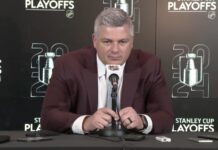This past weekend, the Hockey Coaches Conference came to Toronto in what is fast becoming an annual tradition.
When it first came to Toronto after originally starting in Vancouver, there was a small but passionate turnout. It has now grown into a must-attend event for anyone with an interest in coaching hockey at any level. Over 200 people attended the three-day event from a variety of programs, be it minor hockey, junior programs, college programs, sports media, or professional coaches (and GMs).
I’ve said this before in years past, but the thing that always impresses me most is the camaraderie and approachability of the group. Everyone has time for you, everyone is willing to share ideas, and everyone there is just trying to get better, including the presenters. So kudos to everyone for being extremely generous with their time — and to the event organizers for putting the whole thing together, of course.
All presentations are recorded on video and can be accessed on The Coaches Site website (there is a subscription fee). I should note here that a subscription comes with access to all of the presentations/conferences they’ve hosted in years past as well.
Here are my notes from the weekend and some of the key themes I took away from it.
Pete DeBoer – San Jose Sharks Head Coach
DeBoer’s presentation focused on the Vegas series — one of the more thrilling series we’ve had over the past few playoffs, in my opinion. The format was particularly interesting; after cutting up a bunch of film from the game, DeBoer injected his analysis, emotions, and opinion into what he was seeing as it happened.
Before the video started, DeBoer discussed the importance of building a staff and having open communication with the players. He noted that Lou Lamoriello was the one that taught him about building out a quality staff. DeBoer emphasized that coaches need GMs to get the right players and that the coaches have to, in turn, put those players in the right spots.
DeBoer also mentioned how, in his opinion, physicality is still a big part of the game — that it can help you open space for your players to create, and that intimidation plays a role in deciding the outcomes of games and series.
A few quick ‘strategy’ nuggets from DeBoer that I thought were interesting: First, in the defensive zone, if a defender is guarding someone with the puck while facing the puck carrier’s numbers, the Sharks have a rule that you automatically have to switch off the puck carrier and someone else should then go pick him up (this applies to when the player is circling the net or something as opposed to a battle in the corner). He also said Vegas is very aggressive on the penalty kill about sending two forwards up ice to forecheck, so they tried to make long-bomb stretch passes anytime that was happening in an attempt to catch them out for a 3v2.
In general, DeBoer emphasized exiting the zone clean — if you can come out of your end with the puck and numbers, it sets up everything else. He said the Sharks spend the most practice time on breakouts. He gave Babcock a mention by noting his insistence on getting bodies and action to the net in the offensive zone — something DeBoer believes in as well.
As for the game, DeBoer was quick to note that Vegas was without two top penalty killers on that five-minute major – Cody Eakin was ejected and Pierre-Edouard Bellemare was out of the lineup. He also mentioned that Joe Thornton was the first to speak on the bench after Joe Pavelski was knocked out of the game and said something to the effect of, “Let’s make them pay on this PP.”
Mike Kelly, Vegas’ Assistant Coach, was also at the conference and he wondered if Paul Stastny, a friend of Pavelski’s, was shaken up by the injury and if it impacted him on the subsequent faceoff (which he lost and San Jose scored very quickly off of). Both DeBoer and Kelly also stated that they were very concerned about Pavelski more than anything because he’s not the type of player to stay down.
During the power play itself, Thornton also told DeBoer to keep the others on because he felt they had a better chance of scoring — a completely selfless move by a future Hall of Famer.
DeBoer did a great job of breaking down the film and discussing the emotions of the series. He came across as a completely likeable human-being. You can understand why players would like playing for him and also that he’d be quick to hold players accountable.
Mike Gillis – Former Vancouver Canucks General Manager
Gillis sat down for a Q&A with Ryan Pinder of Sportsnet and gave his viewpoint on a variety of topics. He’s an interesting guy who has a real outside-the-box view on how to approach team building. Gillis is clearly well-read and does not conform to any conventional thinking, although he can also be a bit abrasive and direct in his delivery.
In his time with the Canucks, he was known as an “analytics” GM of sorts, but he said analytics is just a word and how you get/use data is really what’s important. Gillis emphasized the need to start with a problem and then work towards a solution — not simply gather data blindly and draw conclusions from it. While with the Canucks, he mentioned that they used the US military to help them with their sports science and one of their early efforts was looking for optimal playing opportunities.
Sticking with the Leaf theme quickly, Gillis said adding Mats Sundin was instrumental to changing the fabric (re: culture) of the team. I actually forgot that they named Roberto Luongo captain during Gillis’ tenure, and he said it was to try to get more leadership out of him and make Luongo more accountable for losses (Gillis thought it worked). He did note the backlash they received for it and didn’t say if it was worth the aggravation, but he seemed happy with the results, at least internally. He also noted that Luongo suffered from a degree of performance anxiety where he’d actually go through a physical change and his sense of humour would disappear; that was something they had to actively work with him on.
The other player note that I found interesting was Gillis mentioned that Ryan Kesler played with blinders on and that they needed to surround him with players that could carry the puck through the neutral zone and retrieve it on dump-ins (which is why they acquired Chris Higgins to play with him). He also said their thinking was that the Sedins needed to play with a righty (due to Anson Carter’s success there) when really what they needed was a player that could think the game at a high level since the twins are so smart.
As for being a former GM, he had a few thoughts on the position. He said it can be a really debilitating job (Leaf related: look at all the debate over the backup goalie!) and that you need a strong support system to take the pressure off a bit. Gillis thinks organizations need at least four Assistant General Managers. He also believes there is too much group think in scouting, not enough evidence-based decision-making, and not nearly enough analytics that are predictive in scouting.
Gillis made some interesting comments on drafting as well, mentioning that there are many players that are physically capable of playing in the NHL but the issue lies in their decision-making. He argued that there should be cognitive testing of prospects to better understand their thinking.
Moving forward, Gillis thinks the league will continue to push speed and skill and that more speed leads to more danger, so players need to understand that. He also thinks the game could move towards five forwards on the ice at once (My thoughts: Forwards get roasted off the rush and defensively repeatedly. Good defensemen that can control the game should be at a premium and should become more valuable, not less).
Rickard Gronberg – Team Sweden National Head Coach
The Swedish Men’s National Team Head Coach is leading a program that oversees a lot of talent in a nation that is developing loads of top-end talent.
Gronberg talked about meeting players in the middle by having them actively involved in the decision-making process. He noted that it is amazing what you can accomplish when your mind is free, but that players (and staff!) also need clear job descriptions. He also outlined how an active way of playing requires less energy than a reactive approach.
Another note I found interesting is that Sweden scrimmages every practice. They film these scrimmages and go over it like game tape with the players. I’ve heard of a few college programs that are also doing this — taping practices and going over the tape with players. Some teams don’t even use game tape — only practice tape. I like this idea as it focuses on practice habits and doesn’t call out game mistakes. Show players tape where they have the most opportunity to work on it: practice.
Additional Notes and Themes
- Funny enough, Mike Babcock was the hockey coach that the coaches brought up the most as an example on how to do things. I can’t say whether it was pandering to the Toronto crowd or not, but it was interesting and the examples were generally things Babcock is known to do (bringing guys high, possibly out of the zone on the half wall of the PP, picks and bumps down low, etc.).
- Hockey Canada’s video coach Tyler Dietrich provided some interesting tidbits – he said their staff is generally one-to-one staff/player ratio in tournaments (which I think is a little much, but what do I know). He’d have a really interesting perspective on some of the best coaches in the league considering he has worked with so many of them and seen how they operate – they vary in how they review tape, what they look for, clips they show players, how they give feedback, how they empower their staff, etc.
- Interesting stats from John Becanic of Hockey Pyramid for defending 6v5 in the 2019 playoffs – in the 52 times an extra attacker was on the ice, there were seven goals scored by the team that pulled their goalie, 31 empty-net goals, and only one team won a game after scoring to tie the game with the extra attacker (San Jose).
- Loved these stats from Vegas’ Mike Kelly – 72 percent of goals are scored from the house, but only 32 percent of shots are taken from the house area. If you want to score goals, you have to get to the dirty areas. The second highest area for scoring goals? Between the top circles and blue line, in the middle of the ice.
- Almost every coach talked about competing, creating a competitive environment where players hold each other accountable, working the walls, etc. I know these are often thought of as clichés, but honestly, these are the things coaches have the most say on – keeping players accountable re: work ethic. Skill generally needs to be acquired at the NHL level or developed in lower leagues first.
- Part of the conference includes an on-ice component, and while I won’t get into drills, I’ll say that I thought Ryerson’s Head Coach Johnny Duco was particularly impressive. I can see why Ryerson has been trending up with him in charge.
- I also liked Greg Powers of Arizona State University, who recently became a D1 program. Every coach talked about putting in place structure instead of systems and he was even more simple (which I loved): If you are 1) on the right side of the puck, and 2) win your battles, we will win more often than we lose.
- Related: NHL players know how to identify and work around a 1-2-2 or 2-1-2 forecheck or what have you. The work is getting them to buy into their role(s), putting them in the right spots to be successful, acquiring and developing the appropriate talent, and holding players accountable. This was common with every coach.
- Just a personal observation/thought – why did we stop calling backchecking, backchecking? Over the years I’ve heard it called a number of things online and in-person (backpressure, backside pressure), and I don’t get it? It has and always should be backchecking. Get back and check your opponent (not even necessarily with a hit, but at least identify the right guy and cover him). Just a personal pet peeve.




































